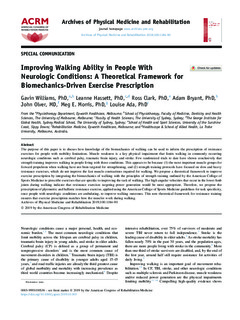Improving Walking Ability in People With Neurologic Conditions: A Theoretical Framework for Biomechanics-Driven Exercise Prescription
Williams, Gavin; Hassett, Leanne; Clark, Ross; Bryant, Adam; Olver, John; Morris, Meg E.; Ada, Louise
Journal article

Åpne
Permanent lenke
http://hdl.handle.net/11250/2601497Utgivelsesdato
2019Metadata
Vis full innførselOriginalversjon
Williams, G., Hassett, L., Clark, R., Bryant, A., Olver, J., Morris, M. E., & Ada, L. (2019). Improving Walking Ability in People With Neurologic Conditions: A Theoretical Framework for Biomechanics-Driven Exercise Prescription. Archives of Physical Medicine and Rehabilitation, 100(6), 1184-1190. https://doi.org/10.1016/j.apmr.2019.01.003Sammendrag
The purpose of this paper is to discuss how knowledge of the biomechanics of walking can be used to inform the prescription of resistance exercises for people with mobility limitations. Muscle weakness is a key physical impairment that limits walking in commonly occurring neurologic conditions such as cerebral palsy, traumatic brain injury, and stroke. Few randomized trials to date have shown conclusively that strength training improves walking in people living with these conditions. This appears to be because (1) the most important muscle groups for forward propulsion when walking have not been targeted for strengthening, and (2) strength training protocols have focused on slow and heavy resistance exercises, which do not improve the fast muscle contractions required for walking. We propose a theoretical framework to improve exercise prescription by integrating the biomechanics of walking with the principles of strength training outlined by the American College of Sports Medicine to prescribe exercises that are specific to improving the task of walking. The high angular velocities that occur in the lower limb joints during walking indicate that resistance exercises targeting power generation would be most appropriate. Therefore, we propose the prescription of plyometric and ballistic resistance exercise, applied using the American College of Sports Medicine guidelines for task specificity, once people with neurologic conditions are ambulating, to improve walking outcomes. This new theoretical framework for resistance training ensures that exercise prescription matches how the muscles work during walking.